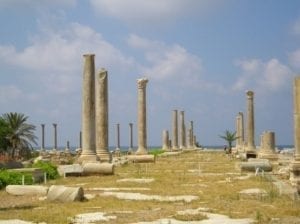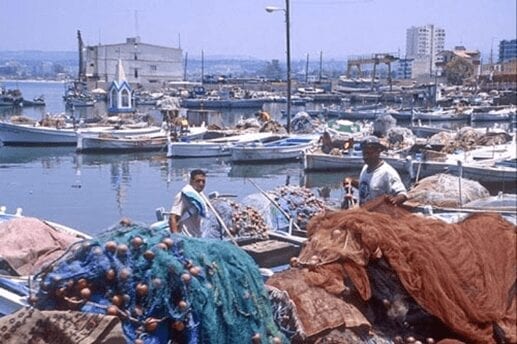Introduction
Old Testament prophets told of what was going to happen in the future. Several prophesied against Tyre. Some condemned the Tyrians for delivering the Israelites to the Edomites and selling them as slaves to the Greeks (Amos 1:9). Jeremiah prophesied against Tyre (Jerimiah 27:1-11), but it is Ezekiel’s prophecy which was made between April 587 BC and April 586 BC,[1] that will be considered here, although all the others were fulfilled as well.
Ezekiel’s prophecy 26: 3-14
…this is what the Sovereign Lord says: I am against you, Tyre, and I will bring many nations against you, like the sea casting up its waves. 4 They will destroy the walls of Tyre and pull down her towers; I will scrape away her rubble and make her a bare rock. 5 Out in the sea she will become a place to spread fishnets, for I have spoken, declares the Sovereign Lord. She will become plunder for the nations, 6 and her settlements on the mainland will be ravaged by the sword. Then they will know that I am the Lord.
7 “For this is what the Sovereign Lord says: From the north I am going to bring against Tyre Nebuchadnezzar king of Babylon, king of kings, with horses and chariots, with horsemen and a great army. 8 He will ravage your settlements on the mainland with the sword; he will set up siege works against you, build a ramp up to your walls and raise his shields against you. 9 He will direct the blows of his battering rams against your walls and demolish your towers with his weapons. 10 His horses will be so many that they will cover you with dust. Your walls will tremble at the noise of the warhorses, wagons and chariots when he enters your gates as men enter a city whose walls have been broken through. 11 The hooves of his horses will trample all your streets; he will kill your people with the sword, and your strong pillars will fall to the ground. 12 They will plunder your wealth and loot your merchandise; they will break down your walls and demolish your fine houses and throw your stones, timber and rubble into the sea. 13 I will put an end to your noisy songs, and the music of your harps will be heard no more. 14 I will make you a bare rock, and you will become a place to spread fishnets. You will never be rebuilt, for I the Lord have spoken, declares the Sovereign Lord.
Comment
The key to understanding Ezekiel’s prophecy is to look at the pronouns, “he” and “They.” Ezekiel began his prophecy with an overall statement by saying that “many nations” would come against Tyre in waves (verse 3). Then he proceeded to name Nebuchadnezzar, and stated that “he” would build a siege mound, “he” would slay with the sword, and “he” would do numerous other things (verses 7-11). However, in verse 12, the pronoun shifts back from the singular “he” to the plural “they.” It is in verse 12 and following that Ezekiel predicts that “they” will lay the stones and building material of Tyre “into the sea.” The shift in pronouns is of vast significance, since it shifts the subject of the action from Nebuchadnezzar (he) back to the many nations (they) of verse 3.
Ezekiel adds an additional comment; Yet he (Nebuchadnezzar) and his army got no reward from the campaign he led against Tyre. (Ezekiel 29:18).
Six predictions regarding the future of Tyre
1 Many nations will come against Tyre in successive waves like the waves of the sea (verse 3).
2 Nebuchadnezzar will destroy the mainland of Tyre (Verse 7-11), but get no reward (29:18).
3 Her settlements on the mainland will be ravaged by the sword (verse 6), implying thatTyre will have another site off the coast.
4 Debris from the city, stones and timber will be thrown into the water (verse 12).
5 Tyre will be made a bare rock, flat like the top of a rock and fishermen will spread their nets over the site (verses 5 and 14).
6 Tyre never will be rebuilt (verse 14).
What actually happened
Nebuchadnezzar attacked mainland Tyre the year the prophecy was pronounced, and after a 15-year siege (586–571 BC), Nebuchadnezzar broke the gates down. He found the city almost empty. The majority of the people had moved by ship to an island about one kilometer off the coast and fortified a city there. The mainland city was destroyed in 573 BC, as prophesied. Tyre remained on the island and was a powerful city for over two hundred years.
Yet he (Nebuchadnezzar) and his army got no reward from the campaign he led against Tyre. (Ezekiel 29:18)
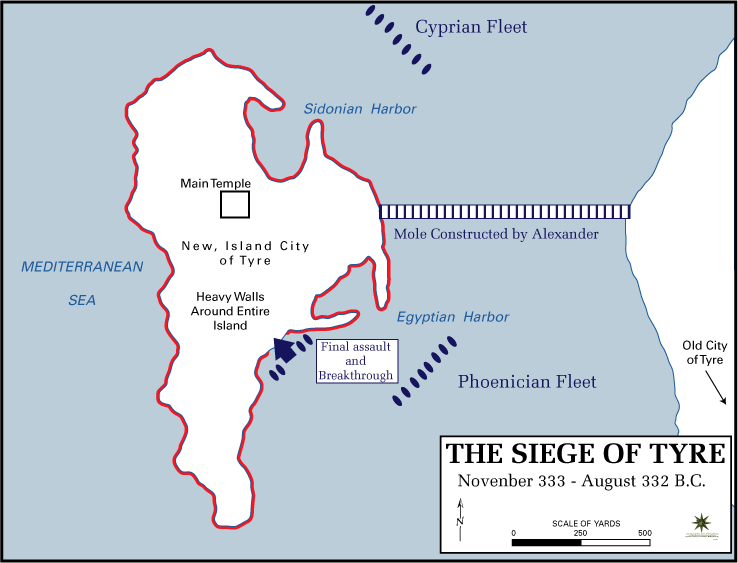 Alexander the Great, as part of his war on Persia, marched southward and called on each city to open its gates to him. Tyre refused and in 332 BC, he blockaded the island city for 7 months, but Tyre held on. Possessing no fleet, he used the debris of the abandoned mainland city to build a causeway or ‘mole’ 60 meters (200 feet) wide across the straits, which separated the old and new cities.[2]
Alexander the Great, as part of his war on Persia, marched southward and called on each city to open its gates to him. Tyre refused and in 332 BC, he blockaded the island city for 7 months, but Tyre held on. Possessing no fleet, he used the debris of the abandoned mainland city to build a causeway or ‘mole’ 60 meters (200 feet) wide across the straits, which separated the old and new cities.[2]
The people of Tyre continually raided the causeway with fire-ships, greatly retarding progress, until Alexander pressured conquered subjects to make ships for his operation. After attaining a superior naval force, Alexander finished the causeway, battered the walls of Tyre down, killed 10,000 of the inhabitants, and sold 30,000 into slavery.
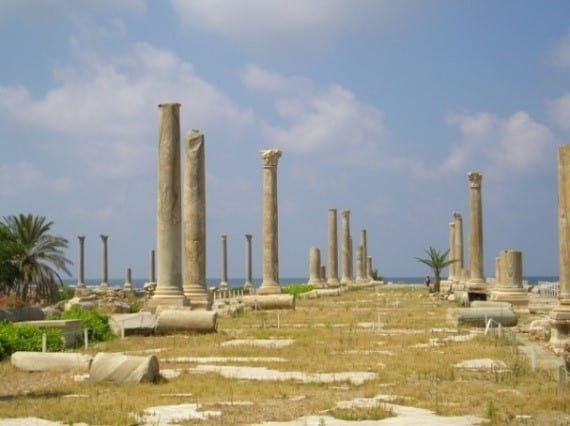 Although Tyre continued to exist after Alexander, Ezekiel saw one nation after another coming against her like ocean waves on a beach. Many nations did come against Tyre in successive waves as per the prophecy; the Persians, Macedonians, Ptolemies, Seleucids and Romans; in AD 638 the Arabs, and finally, in 1291, the Mameluke Muslims destroyed the city completely. What is seen today on the ancient site are Roman ruins as shown.
Although Tyre continued to exist after Alexander, Ezekiel saw one nation after another coming against her like ocean waves on a beach. Many nations did come against Tyre in successive waves as per the prophecy; the Persians, Macedonians, Ptolemies, Seleucids and Romans; in AD 638 the Arabs, and finally, in 1291, the Mameluke Muslims destroyed the city completely. What is seen today on the ancient site are Roman ruins as shown.
According to the Columbia Encyclopedia, Fifth Edition:
The principal ruins of the city today are those of buildings erected by the Crusaders. There are some Greco-Roman remains, but any left by the Phoenicians lie underneath the present town.
Philip Myers[3] writes in his book:
Alexander the Great reduced Tyre to ruins in 332 BC. Tyre recovered in measure from this blow, but never regained the place she had previously held in the world. The larger part of the site of the once great city is now bare as the top of a rock; a place where fishermen now spread their nets to dry.
The Sidonian port of Tyre is still in use today. Small fishing vessels lay at anchor there. An examination of the foundations reveals granite columns of the Roman period which were incorporated as binders in the walls by the Crusaders. The port has become a haven today for fishing boats and a place for spreading nets as shown.[5]
Conclusion
All the prophecies of Ezekiel about Tyre have come true. Nebuchadnezzar destroyed the mainland city of Tyre, yet he got no reward for his campaign, Alexander threw debris into the water to make the causeway thereby enabling him to attack the island city, many nations came against Tyre, it was left as a bare rock, fishermen now spread nets over the site, the old city has never been rebuilt. Today there is a city called Tyre, but it is not the original as this still lies bare, but rather buildings have been constructed around the original city. All six prophecies have come true in the minutest detail.
Below is modern-day Tyre from the air. Notice how sand has built up around the causeway Alexander built.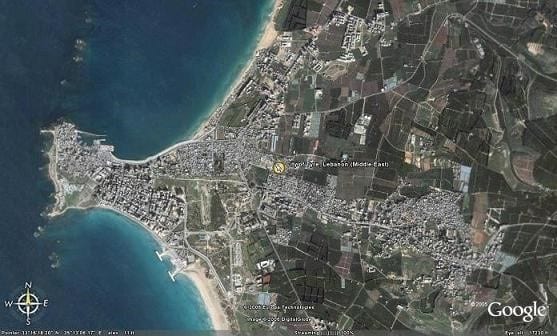
[1] In verse 1, Ezekiel states that the word of the Lord came to him, In the eleventh year, on the first day of the month. He does not say which month but it was the eleventh year of Nebuchadnezzar’s reign, which was from April 23, 587 to April 13, 586 BC.
[2] Courtesy of the Department of History, United States Military Academy.
[3] P. Myers, A General History for Colleges and High Schools, Boston, Ginn and Company, 2003, page 55.
[4] N. Jidejian, Tyre Through the Ages, Beirut, Dar El-Mashreq Publishers, 1969, page 139.
[5] The image is courtesy from BibleArcharology.org.
